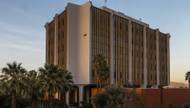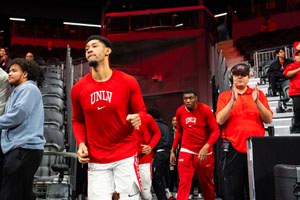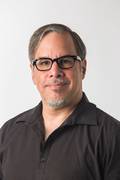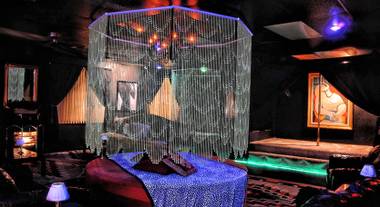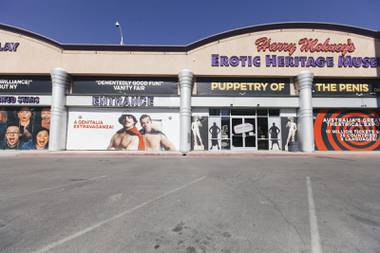A 700-acre medical district, stretching from University Medical Center on Charleston Boulevard to the Lou Ruvo Clinic for Brain Health in Symphony Park, is beginning to take shape. Las Vegas City Manager Betsy Fretwell says $100 million dollars’ worth of road and infrastructure improvements are coming to the area over the next five years, creating shaded, pedestrian streets suitable for busy professionals in white coats and scrubs. Shops, restaurants and apartments will spring up in a new neighborhood Fretwell describes as “active, vibrant and well-networked”—and within 15 years or so, it might even be connected to UNLV and McCarran by a light rail line.
But none of this would be happening if the Las Vegas Medical District didn’t have at its center a brand-new medical school. The UNLV School of Medicine isn’t some distant dream; its first classes will meet this year, even before its architecturally striking campus is built. Barbara Atkinson, the founding dean of this important new school, explains to the Weekly why that tired airport joke will soon be forgotten.
How badly has Las Vegas needed a medical school?
I think people have wanted a full medical school in Las Vegas for over 30 years, because of the doctor shortage in Nevada. Overall, in doctors per 100,000 [residents], I think we're about 47th out of 50 states. There's not much specialty medicine that's being trained here. There has been one MD school in the state, and it’s in Reno. So there's been this medical need for a long time, but because there’s already one school in the state, there was never a real push to get a school here. (Note: Touro University has been offering accredited degrees in osteopathic medicine since 2004.)
Then, about three and a half years ago, Brookings Mountain West and a consulting firm, Tripp Umbach, were hired to do a study of what was missing in Las Vegas’ economy. That's actually the study that was used to justify the school. It wasn't the unmet medical care that was missing. It was that there was a huge piece of the economy of Las Vegas missing. … They estimated that, if you had a public medical school in Las Vegas, it would be worth $1.2 billion a year after 15 years of startup, and people would be less apt to leave Las Vegas for medical care. There'd be less moving to California, Arizona and Texas, which is what has been happening to date.
And that’s how the UNLV School of Medicine came to be.
That's pretty much the fine [points] of it. It's interesting to me that the medical need is the real need, but … if you actually put a medical school in the medical district of the City of Las Vegas, it's worth even more money. It's really a substantial economic impact from a pretty modest investment.
So, the decision was made to start [a medical school] under UNLV. I was recruited as dean about two and a half years ago. About two weeks before I started work, I developed a 10-year budget. The governor put money in his budget for beginning the school, and then the legislature actually added money to it. We ended up getting about $27 million for the start—$7 million for the first year, and $20 million in the second year, which is the current year. We've requested additional money now that we're accepting students for the next two years, and that money was also put in the governor's budget. We're hopeful that the legislature will approve additional money for us to continue to expand the school.
How will our medical school stand apart from those at other universities? What will make it a 21st-century facility?
That's the good thing about starting a new school. Everything changes. You have to teach students to think and to find information, to work as part of teams and to be able to adapt to new technologies that come. We can't begin to imagine what the medicine of the next 50 years is going to look like. When I was in medical school, we had just X-ray. We didn't have CTs and MRIs and things like that. So you have to be willing to adapt to what the future is going to bring. All the drugs that I knew in medical school … aspirin is about the only one that's still being used from back then. So you have to teach them to really work together.
Using that 50-year timeline as a goal for planning the curriculum, I looked at all the new schools and anything that I thought was really special. Then I began hiring… Just about two years ago, we recruited the vice dean for education and the senior dean for student admissions and student affairs. … I went to a school in Philadelphia that was 150 years old. It's pretty hard to change a school that's been doing that pretty much the same way for a long time, and other people had that experience, too. So we got a group of people who are really interested in what the best techniques are. We devised a curriculum that for the first year-and-a-half starts out with the students becoming certified as EMT, which one other new school on Long Island had started doing. I thought was a great way to introduce students to medicine very quickly, to have them work as part of teams where doctors aren't even the leaders of the team.
And then?
Then they're going to go into a column-based curriculum which teaches them how to teach each other all the basic principles of medicine, which is the normal body anatomy, the normal physiology, the biochemistry, and then all the other abnormalities, all the types of diseases. …They’ll learn as part of a patient care model. I think then they'll remember it better as they go on to see patients.
In the past, the normal anatomy and histology of the body was taught by putting a slide under a microscope, and then by actually dissecting a human body. We're going to be doing it with X-rays, with MRIs, CT scans—the big tables that are essentially TV monitors with CT bodies embedded that can be taken apart in a variety of ways. You actually get to see everything the way you would see it in a patient’s X-ray or CT scan on a patient. I think they'll get much more out of it, and it will be much more like the reality of taking care of patients—but it will certainly be a major technological difference in the way things are now done.
But they’ll still be doing hands-on work, right?
One of the most interesting pieces of our curriculum is that instead of being in the hospital doing shifts, we want students to do a whole outpatient year. … If you want to learn how to treat diabetes, you don't do it by seeing a patient for two days in crisis. You do it by taking care of a patient in an outpatient setting over a whole year.
It's a varied curriculum. It has a lot of social and health pieces to it. It looks at major issues in Las Vegas. We've picked [several] major social issues that we want to be sure that we teach them—things like addiction and homelessness, human trafficking, obesity, diabetes, depression, and basically mental health disease in general, because it’s a major problem in the community.
When are the first classes set to begin?
The first class starts on July 17. On July 1, the current faculty and staff who live in Las Vegas [but work for] the Reno School of Medicine are all moving over to become part of UNLV. That's about 700 people. We're going to have somewhere between 800 and 850 people working for the School of Medicine by this summer, and then the students will start on the 17th. Then, of course, we'll have class every year thereafter.
How many local students will be in that class?
We're only interviewing Nevada residents right now. We had 905 applicants for our 60 spots, and 400 of them were either from Nevada or had relatives that lived here, or some ties to Nevada. So we basically made a decision to only take Nevada kids for those 60 spots. We have a great pool of them.
And when do you expect they’ll move into the amazing new facility we’ve seen in those renderings?
We currently [have] space for students in their first two years, but we have to build out for students in their third and fourth years. We're requesting money from donors for a medical education building that would hold 120 students in a class, and actually has “shelf space” so that, 10 or 15 years from now, we can have 180 students in a class. Then we would plan on putting a clinical facility in North Las Vegas and one in Henderson, because we really want to be able to manage the care of a variety of people across the whole Valley.
But it all starts in the city core. What makes the Las Vegas Medical District such a perfect spot for this school, aside from its proximity to UMC?
It's very central to everything. That's probably the biggest thing. Our major hospital is going to be UMC. We're doing a major affiliation agreement with them, but you’ve also got Valley Hospital right there, and a lot of other medical facilities in that area to build on—outpatient radiology, nursing homes, those kinds of facilities. We obviously need to build a lot more of them, and that's what will bring the economic impact to the area.

